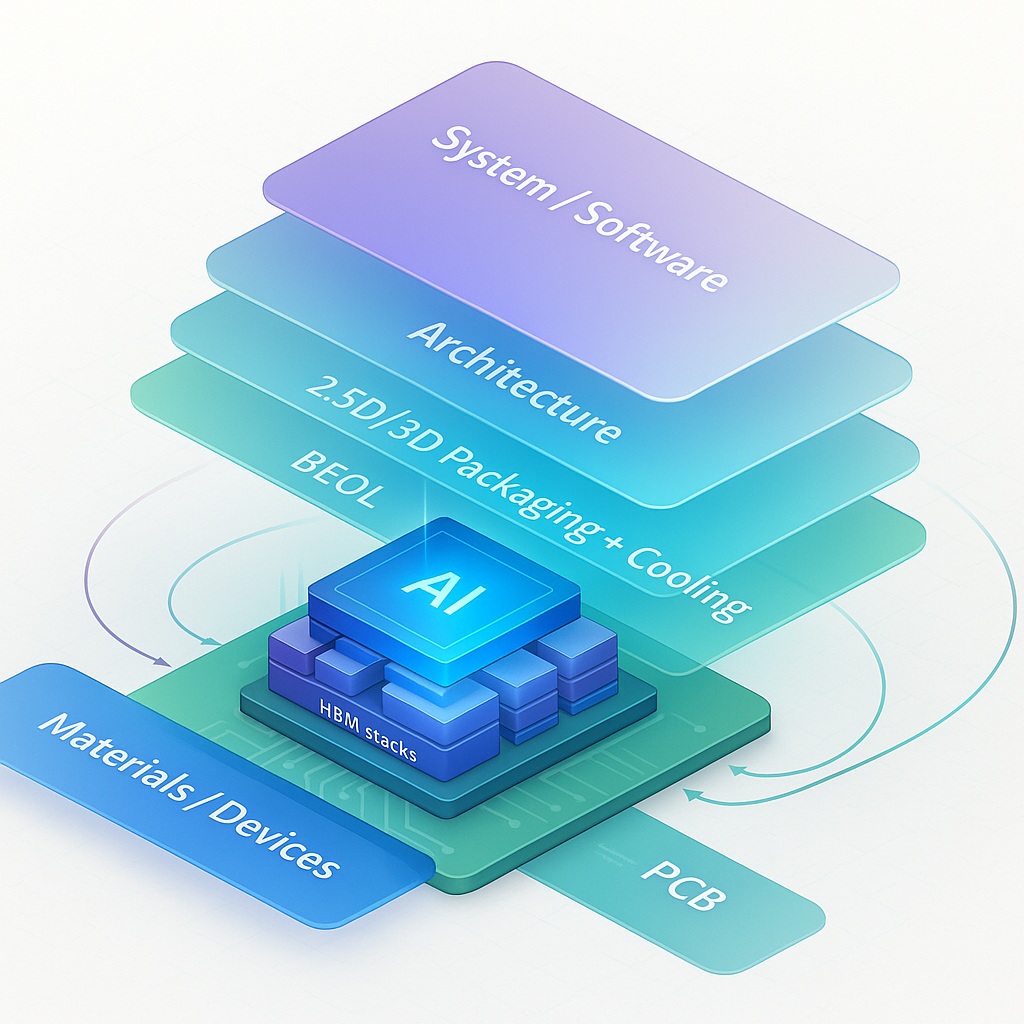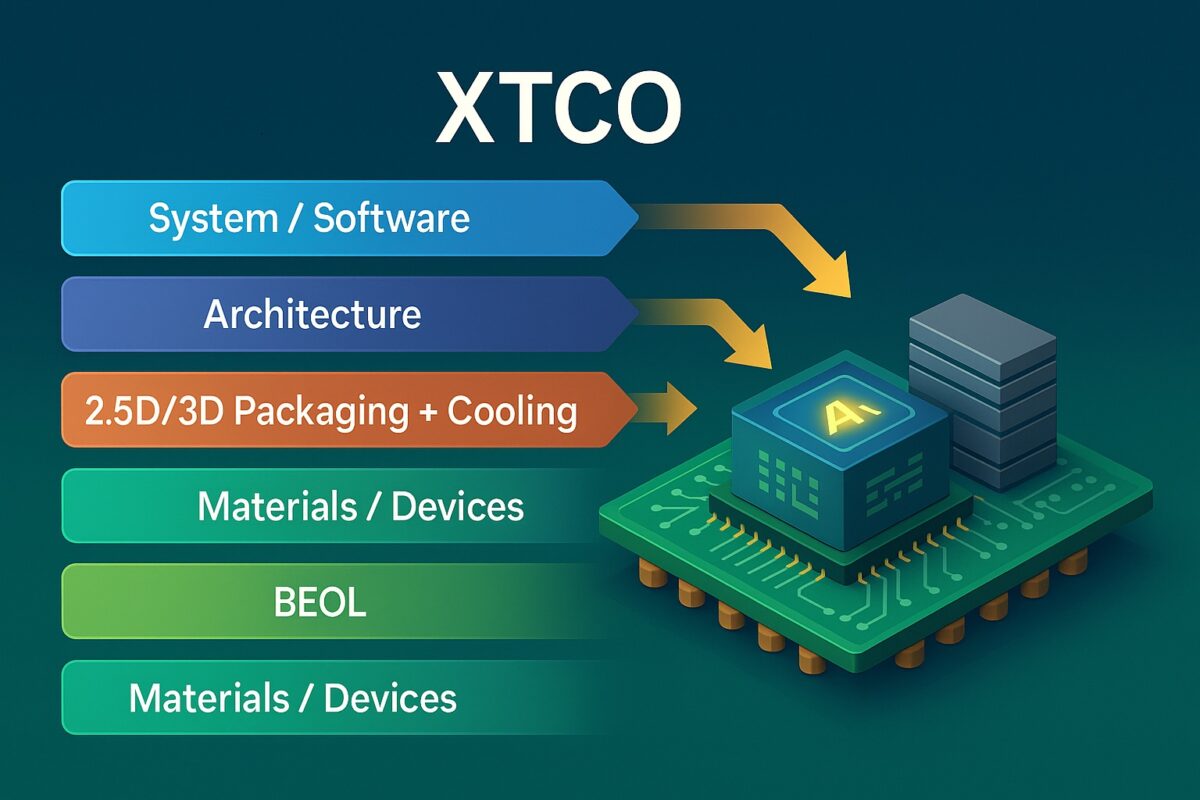XTCO (Cross-Technology Co-Optimization) is a holistic methodology that coordinates multiple layers of technology and design—devices, interconnect/BEOL, 3D integration & packaging, architecture, and system/software—to deliver target PPAC (performance, power, area, cost) plus reliability and time-to-market. It generalizes prior co-optimization frameworks such as DTCO (design-technology) and STCO (system-technology) into a single, end-to-end stack used to break modern system-scaling bottlenecks.
What XTCO Covers (the stack)
-
Materials & Devices: transistor options (nanosheet, forksheet, CFET), backside power, device reliability.
-
Interconnect/BEOL: RC scaling, via resistance, BEOL materials, BSPDN routing.
-
3D & Packaging: 2.5D/3D chiplets, hybrid bonding, HBM proximity, thermal/mechanical co-design.
-
Architecture & Workloads: partitioning into chiplets, memory hierarchy, fabrics, near-memory compute.
-
System & Software: board/cooling, firmware, compiler/runtime choices that change activity factors and power.
XTCO orchestrates trade-offs across these layers rather than optimizing any one in isolation.
Why XTCO?
-
Post-Dennard era: Gains come from co-design, not just smaller transistors.
-
Chiplet economics: Partitioning and packaging choices now rival node shrinks in impact.
-
Thermal & power limits: Cooling, PDN, and floorplanning must be decided with workload behavior in mind.
-
Predictable delivery: Early techno-economic models steer PPAC and schedule/risk.
Core Loop (typical XTCO workflow)
-
Top-down targets: System KPIs (throughput/latency, power envelopes, cost, reliability).
-
Architectural partitioning: Explore monolithic vs. chiplet graphs; memory/HBM placement.
-
Technology option sets: Devices/BEOL, BSPDN, 3D stack, packaging flows (CoWoS/FO-PLP/Foveros, etc.).
-
Design-space exploration: Multi-physics + EDA models for timing, SI/PI, thermals, yield, cost.
-
Down-selection & prototyping: Close on feasible PPA/thermal/yield corners; de-risk with early vehicles.
-
Sign-off with guardbands: Include variability, aging, supply chain and manufacturability checks.
Key Methods & Models
-
Hierarchical PPACe: Add e (embodied energy/carbon) to PPAC when relevant.
-
Yield & cost coupling: Known-good-die assumptions, compounded yields for 3D/2.5D, COGS vs. throughput.
-
Thermal-electrical co-simulation: PDN + heat-flow + activity traces from real workloads.
-
Interconnect-aware DSE: Fabric topology, reticle/bridge limits, package RDL and via budgets.
Common Deliverables
-
Partition maps (chiplets, HBM stacks, bridges).
-
Techno-economic dashboards (PPACe vs. options).
-
Risk burndown plans (cooling, warpage, alignment, test).
-
Interfaces & standards selections (UCIe, CXL/PCIe) aligned to packaging limits.
Prime Use Cases
-
AI/HPC accelerators: Balance node choice, HBM count/placement, 3D cache, and liquid cooling.
-
Dense edge systems: Co-optimize BSPDN, 3D DRAM proximity, and packaging for size/power limits.
-
Networking & CPO: Optimize SerDes reach, co-packaged optics adjacency, and thermal paths.
Relationship to DTCO/STCO
-
DTCO focuses on design ↔ process for a node.
-
STCO lifts to system ↔ technology trade-offs.
-
XTCO spans cross-layer decisions and programs that coordinate DTCO & STCO with packaging and compute-density roadmaps. (Several research and industry forums now run dedicated XTCO sessions and leadership roles.)
Metrics to Watch
-
PPA & PPACe trajectories across option sets
-
Energy per task / per token (AI), perf/W
-
Thermal density & cooling ΔT, IR-drop margins
-
Compound yield & cost per good system
-
Time-to-market (TtM) vs. risk gates
Typical Challenges
-
Model fidelity vs. exploration speed; aligning EDA/TCAD/packaging tools
-
Data hand-offs between teams (device ↔ package ↔ system) and IP confidentiality
-
Early availability of accurate package/cooling PDKs
-
Supply-chain synchronization across foundry, OSAT, substrate, and cooler vendors
Notable Quotes (unattributed)
-
“XTCO turns isolated optimizations into a contract between device, package, and system.”
-
“In the chiplet era, the package is part of the architecture—XTCO makes that explicit.”
-
“If it isn’t modeled together, it won’t land together—performance, power, thermals, cost.”
-
“You don’t win PPAC; you budget it across layers.”
-
“Workloads are the spec—XTCO starts from software behavior and works down.”













Jensen Huang Drops Donald Trump Truth Bomb on Joe Rogan Podcast